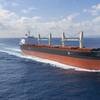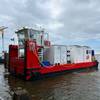By Rob Stephenson and Bruce Tennant, McKay Creek Tech.; and Don Hartle and George Geatros Vancouver Shipyards Co. Ltd.
Vancouver Shipyards is part of the Washington Marine Group, the largest shipbuilding, ship maintenance and repair, and marine transportation company in Canada. Inherent to this scale of operation, the Washington Marine Group generates large quantities of emulsified oily wastewater. Managing the oily bilge water, ballast water, fuel/slop tanks, tank wash water from gas freeing operations, and wastewater from pressure washing machinery was becoming a big and expensive problem at Vancouver Shipyards. Both salt and fresh wastewaters are contaminated with emulsified oil and grease, diesel, hydraulic oil, and a full range of marine fuel oils, plus heavy metals and suspended solids.
The commercially available technologies to treat these sorts of wastewaters were evaluated. No surprise: no system had even a remote likelihood of reliably meeting effluent discharge requirements for the wide range of Shipyards' wastewaters at reasonable cost.
Subsequently, through good fortune and even better timing, the company stumbled across an old technology called "electrocoagulation" or EC. Despite innumerable false starts and misinformation about the process, it actually worked.
Of course, there are many steps between a victory and an operating wastewater treatment plant. In brief, two years after our rediscovery of EC, a plant was built at Vancouver Shipyards, which has been operating for the past four years.
Background: Oil And Water
Don't Mix — Or Do They?
Petroleum hydrocarbons are present in wastewater both as "free oils" (oils that float to the liquid surface) and as "emulsified oils" (oils that are in stable suspension and neither sink nor float).
Many commercially available systems such as coalescing plates and rope skimmers are effective to remove free oil. These devices exploit the characteristic of oils to stick to solid surfaces, concentrate there, and later slough off, and thus separate from the bulk liquid.
For typical batches of Vancouver Shipyards' wastewater, the contaminant levels still remaining in the wastewater following free oil removal are far too high to allow discharge, even to sewer. Therefore further treatment of the emulsified oily portion of the wastewater is necessary.
The extent to which oils are emulsified in wastewater depends upon the type of oil, the amount and type of industrial cleaners used, the water temperature, as well as the extent of mechanical agitation, primarily from power washing and pumping.
Until now, no system could effectively treat emulsified oily wastewater in a simple, reliable, and low cost manner. The technologies that were considered to treat emulsified oily wastewater at Vancouver Shipyards are summarized in Table 1.
Electrocoagulation
During assessment of prospective oily wastewater treatment technologies, the company became acquainted with an emerging technology known as "electrocoagulation" or EC. The trouble is, this technology has been "emerging" since 1906 when the first U.S. patent on EC was awarded. Chronically trumpeted as a wastewater treatment panacea, its fundamentals are poorly understood. Consequently, EC has not been keenly embraced by industry. Electrocoagulation (EC) uses an electrical current to dissolve an aluminum anode to coagulate oil droplets and solids that are suspended in wastewater. Gas bubbles formed by EC buoy the oily flocs up to the surface of the treated wastewater for removal by overflow.
Although EC was first demonstrated in 1906, there have not been sufficient incentives, either financial or regulatory, for industry to adopt the process. This of course is changing, and now a greater awareness of pollution, together with regulatory requirements, has industry seeking low-cost and robust technical solutions to solve their wastewater management problems.
Wastewater Treatment Plant Operations
Figure 1 is the process flow diagram of the U.S. and Canadian patented (international patents pending) electrocoagulation wastewater treatment plant at Vancouver Shipyards.
Each batch of wastewater is treated by the WWTP according to the following eight processing steps:
Figure 1: Process Flow Diagram of the Electrocoagulation Wastewater Treatment Plant at Vancouver Shipyards
• From vacuum trucks, tanker trucks, or even from buckets or drums, wastewater is pumped to the receiving tank of the plant.
• Free oil (that which readily separates by gravity) is removed from the feed tanks by a coalescing plate filter. This oil is then sent out to a used oil contractor for recycling.
• The emulsified oily wastewater, now with most of the free oil removed, is pumped to feed tanks.
• The emulsified oily wastewater is then pumped through the electrocoagulation cell at a flow rate of 20 to 30 U.S. gallons (nominally 75 to 100 liters) per minute, depending on the contaminant load.
• A liquid polymer is pumped into the EC treated wastewater just prior to flowing through an in-line mixer and then to a flotation cell.
• A flotation cell splits the treated wastewater stream into two portions: (1) a treated water underflow that is largely free of suspended solids, and (2) a separated solids overflow that contains a concentrated slurry of coagulated contaminants.
• The coagulated contaminants in the separated solids stream are de-watered by means of a plate and frame pressure filter and are disposed of in 55-gallon drums as Hazardous Waste. The liquid filtrate from the pressure filter flows to the sump for return to the feed tank to be treated once again.
• The treated water is discharged through activated carbon filters to the municipal sanitary sewer. Spent activated carbon is managed as Hazardous Waste.
EC Treatment Plant Performance
For four years, Vancouver Shipyards has discharged treated water to meet environmental regulatory requirements for petroleum hydrocarbons, suspended solids, PAHs, BETX, and heavy metals. The treated discharge is always clear and colorless. Table 2 summarizes performance.
Electrocoagulation does not destroy contaminants, but rather separates them from the bulk volume of the wastewater. Prior to solids de-watering, the volume of the overflow slurry of coagulated contaminants is roughly one percent that of the treated wastewater. It de-waters easily by means of a standard plate and frame filter press. The de-watered solid residuals look and feel like axle grease and are managed as Hazardous Waste.
At Vancouver Shipyards one operator is needed to perform routine operations and maintenance, complete paper work, receive wastewater, manage Hazardous Wastes, power wash equipment, and start up and shut down the plant. Operated without computers, it is "Operable by a shipyard's laborer and fixable with a big hammer."
Footprint
Subsequent to developing this prototype plant, efforts to further simplify and shrink the process have been underway. Not including wastewater storage tanks and de-watering equipment, a 20 to 30 USGPM plant can fit into a 4 x 12-ft. space, 8 ft. high.
Electrocoagulation has proven to be by far the lowest cost technology to reliably treat the emulsified oily wastewater at Vancouver Shipyards. McKay Creek Technologies' electrocoagulation wastewater treatment process has recently been awarded a U.S. patent and a Canadian patent. An international patent examination is currently underway.
Subscribe for
Maritime Reporter E-News
Maritime Reporter E-News is the maritime industry's largest circulation and most authoritative ENews Service, delivered to your Email five times per week










